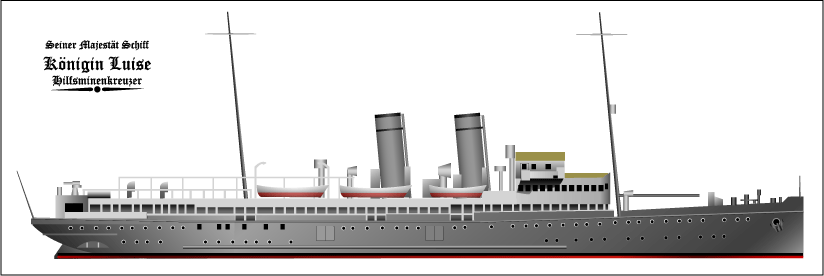
United Kingdom vs. Germany
First naval action of the war
The very first action of the great war occurred on seas: The Staff of the Hochseeflotte had developed a comprehensive plan for years to come in the event of a war with Britain. It was firstly to undermine British ports and disrupt coastal shipping and traffic areas before any action being taken the Royal Navy, and secondly to make bombing raids of British coastal towns to attack population’s morale.
As part of the first action, the German naval command mobilized on August 04 in the morning, former ferry Königin Luise, requisitioned and converted for the Hochseeflotte as “hilfsminenkreuzer” (auxiliary cruiser minelayer). In this context the ship was quickly fitted out with mine rails, while two 37 mm guns taken from old stocks were installed at the stern. The night of 3-4 August, she was also provided with facilities to install two 88 mm, but the rush prevented this and she was to be to painted in a new livery and load 200 mines fastened to buoy ropes on board instead.

Centerpiece of this event, SMS Königin Luise, auxiliary cruiser/minelayer in august 1914.
Beginnings
August 5, in the morning, the ship left Cuxhaven unescorted and headed towards the Thames with a mission to establish there a minefield. The Thames was a deep and well dredged river and probably the most vital artery for the British trade towards the interior of Sussex and London in particular. The traffic there was so much that Königin Luise traveling at 16 knots was not even spotted when crossing an upcoming squadron of destroyers, thanks to her new, hastily painted livery that betrayed her identity, and went on her way unmolested to its objective.
There she spent the afternoon quietly and eventually laid her mines off the estuary, crossing rare ships without awakening suspicion. However in the British Admiralty, intelligence services report stated that German missions were underway, or warned of expected German mines being laid down. The SS Königin Luise is often mismatched with the much larger Barbarossa class liner (1897). More on this

The other SS Königin Luise was a recent steam ferry operated by the Hamburg America Line, laid down in AG Vulcan Stettin in 1913.
The British counterstroke
The squadron of the Thames, composed of Amphion, and two flotillas of destroyers (height in all) is eventually informed, and headed full speed ahead to the mouth of the Thames. The German ship was currently completing its mission and was preparing to return to Cuxhaven. At 11:40 p.m., HMS Amphion made eye contact with the ship, which then immediately leaved, and a hot pursuit ensured.
Faster, destroyers Lance and Landrail running at 29 knots were the first to catch the German ship (only capable of 21 knots). These made a few warning shots with their 102mm forward of the ship to order her stopping. Then both destroyers went parallel to KL, still firing warning shots at a distance, while HMS Amphion, slower, fired to the rear. The German ship could only answer with its 37 mm and had to prepare for torpedoes at close range. The duel was uneven and eventually SMS KL took many hits 102 mm from the destroyers cross-sides.
The end of the Königin Luise
Pounded at the rear in addition, the KL receives the final blows of Amphion, as dark fell at 0:00 at 51 ° 52 ‘north and 02 ° 30’ east. Survivors were rescued until dawn, and then the squadron set sail to its base. The Amphion will – ironically – be responsible for rescuing other sailors victims from the minefield laid by Königin Luise, and was struck at 18:00 by several of them, sinking in no time with great loss of life. So it was the most prized victim of the German ship. The destroyers, who strived to recover survivors were running slowly, watching cresting waves that indicate position of the mines, helping to spot and sweep these the day after, while many transport passing by were duly notified. Such event served as a lesson also to the Royal Navy, that, duly warned, from then on multiplied patrols, and was more suspicious about possible misidentified civilian ships.

 Latest Facebook Entry -
Latest Facebook Entry -  X(Tweeter) Naval Encyclopedia's deck archive
X(Tweeter) Naval Encyclopedia's deck archive Instagram (@navalencyc)
Instagram (@navalencyc)





 French Navy
French Navy Royal Navy
Royal Navy Russian Navy
Russian Navy Armada Espanola
Armada Espanola Austrian Navy
Austrian Navy K.u.K. Kriegsmarine
K.u.K. Kriegsmarine Dansk Marine
Dansk Marine Nautiko Hellenon
Nautiko Hellenon Koninklije Marine 1870
Koninklije Marine 1870 Marinha do Brasil
Marinha do Brasil Osmanlı Donanması
Osmanlı Donanması Marina Do Peru
Marina Do Peru Marinha do Portugal
Marinha do Portugal Regia Marina 1870
Regia Marina 1870 Nihhon Kaigun 1870
Nihhon Kaigun 1870 Preußische Marine 1870
Preußische Marine 1870 Russkiy Flot 1870
Russkiy Flot 1870 Svenska marinen
Svenska marinen Søværnet
Søværnet Union Navy
Union Navy Confederate Navy
Confederate Navy Armada de Argentina
Armada de Argentina Imperial Chinese Navy
Imperial Chinese Navy Marinha do Portugal
Marinha do Portugal Mexico
Mexico Kaiserliche Marine
Kaiserliche Marine 1898 US Navy
1898 US Navy Sovietskiy Flot
Sovietskiy Flot Royal Canadian Navy
Royal Canadian Navy Royal Australian Navy
Royal Australian Navy RNZN Fleet
RNZN Fleet Chinese Navy 1937
Chinese Navy 1937 Kriegsmarine
Kriegsmarine Chilean Navy
Chilean Navy Danish Navy
Danish Navy Finnish Navy
Finnish Navy Hellenic Navy
Hellenic Navy Polish Navy
Polish Navy Romanian Navy
Romanian Navy Turkish Navy
Turkish Navy Royal Yugoslav Navy
Royal Yugoslav Navy Royal Thai Navy
Royal Thai Navy Minor Navies
Minor Navies Albania
Albania Austria
Austria Belgium
Belgium Columbia
Columbia Costa Rica
Costa Rica Cuba
Cuba Czechoslovakia
Czechoslovakia Dominican Republic
Dominican Republic Haiti
Haiti Hungary
Hungary Honduras
Honduras Estonia
Estonia Iceland
Iceland Eire
Eire Equador
Equador Iran
Iran Iraq
Iraq Latvia
Latvia Liberia
Liberia Lithuania
Lithuania Mandchukuo
Mandchukuo Morocco
Morocco Nicaragua
Nicaragua Persia
Persia San Salvador
San Salvador Sarawak
Sarawak Uruguay
Uruguay Venezuela
Venezuela Zanzibar
Zanzibar Warsaw Pact Navies
Warsaw Pact Navies Bulgaria
Bulgaria Hungary
Hungary

 Bundesmarine
Bundesmarine Dutch Navy
Dutch Navy Hellenic Navy
Hellenic Navy Marina Militare
Marina Militare Yugoslav Navy
Yugoslav Navy Chinese Navy
Chinese Navy Indian Navy
Indian Navy Indonesian Navy
Indonesian Navy JMSDF
JMSDF North Korean Navy
North Korean Navy Pakistani Navy
Pakistani Navy Philippines Navy
Philippines Navy ROKN
ROKN Rep. of Singapore Navy
Rep. of Singapore Navy Taiwanese Navy
Taiwanese Navy IDF Navy
IDF Navy Saudi Navy
Saudi Navy Royal New Zealand Navy
Royal New Zealand Navy Egyptian Navy
Egyptian Navy South African Navy
South African Navy






























 Ukrainian Navy
Ukrainian Navy dbodesign
dbodesign